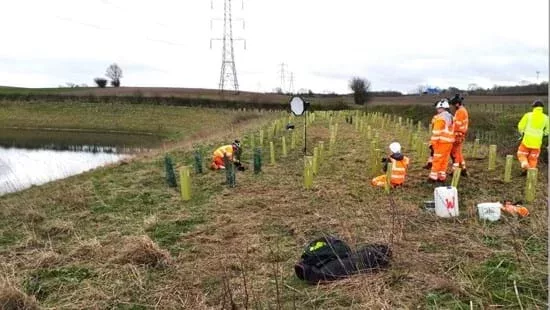Yorkshire’s forests continue to flourish with the creation of new green corridors, helping to build homes for wildlife as National Highways celebrates Nature Week.
Yorkshire’s forests continue to flourish with the creation of new green corridors, helping to build homes for wildlife as National Highways celebrates Nature Week.
Future generations will be able to watch more than 5,000 trees and shrubs grow after they were planted by National Highways. The project is part of the organisation’s commitment to bring more trees around its motorways and major roads.
The new plants have been placed at five locations near junction 42 of the A1M north of Leeds, close to Micklefield, South Milford and Fairburn, which fall within the White Rose Forest and the Northern Forest.
National Highways Senior Environmental Specialist Tim Haskell said: “Roadside verges and nearby land and wetlands are home to diverse wildlife, insects and natural habitats, and it’s very important to us that we protect these areas as well as build new, sustainable ones.
“We’ve planted various native broadleaved species in that area to increase woodland cover in the region and support animals, insects and birds. These include English Oak, which supports more biodiversity than any other tree species in the UK, Field Maple, a broadleaf attractive to caterpillars and aphids and a species which resists air pollution and Hazel, which has long been associated with pollen for bees and food for woodpeckers, nuthatch, and dormice.”
As well as contributing to the Northern Forest project, the new trees and shrubs contribute to National Highways’ wider aim of increasing woodland cover in England to 12 per cent.
The planting of trees was made possible through National Highways’ Designated Fund. It’s just one of the nature-focussed projects taking place near National Highways’ road network during its Nature Week.
National Highways is one of the country’s largest landowners, with 30,000 hectares of green land.
Mr Haskell added: “Tree canopy cover in this part of the country is just over seven and a half per cent, considerably lower than the national average of 13 per cent.
“The saplings we have planted will in time act as carbon sinks. They’ll provide much-needed habitat connectivity for wildlife and improve soil stability as well as slow the flow of flood water on to the road network.
“We’re not just planting for the landscape. We’re planting for ecology as well, developing a green corridor to link our cities and our wildlife.”
The planting comes as National Highways launches Nature Week. To mark UN Biodiversity Day (22 May), the government’s strategic roads operator is highlighting nature focused work by the company and partners around the country.
Last week it unveiled its new Environmental Sustainability Strategy setting out the company’s vision for A connected country- A thriving environment – ambitious plans to deliver a more sustainable road network that not only connects the country but also protects and enhances the environment over the next three decades.
The company’s ambition is to not only mitigate the impact of England’s busiest roads but ensure they can be used as a force for good for generations to come.
As one of the country’s largest landowners with 30,000 hectares of green land, it is vital that National Highways commits to using its green land to reconnect habitats, reverse the decline in biodiversity, help wildlife thrive and build in environmental resilience to a changing climate.
National Highways manages four designated funds, allocated by the Government, to deliver benefits above and beyond building, maintaining and operating England’s strategic roads.
The planting has been funded from National Highways’ Environment and Well Being Designated Fund, which supports the company’s vision of a greener, more sustainable road network.
The funding for the White Rose Forest is split into £15,000 for detailed design, £60,000 for implementation in 22/23. This will be followed with £15,000 per year for the following five years to establish the new trees.
White Rose Forest
The White Rose Forest is the community forest for North and West Yorkshire, working in partnership with local authorities, landowners, businesses, and communities to increase woodland across the region. It is the largest of England’s thirteen community forests and part of the Northern Forest that will stretch from Liverpool to the Yorkshire coast.
Northern Forest
The Northern Forest is a plan to plant 50 million trees in and around the northern cities of Liverpool, Manchester, Leeds, Sheffield and Hull over the next 25 years requiring an estimated £500m of investment.
The Northern Forest is a joint initiative between conservation charity The Woodland Trust and four community forests in the north of England, The Mersey Forest, Manchester City of Trees, the White Rose Forest, and Humber Forest. It will see the planting of at least 50 million trees over the next 25 years, that will help transform the landscape from Hull in the East to Liverpool and Chester in the West. Since 2018 more than three million saplings have gone in the ground.





















